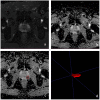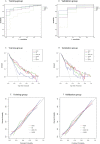MRI radiomics predicts progression-free survival in prostate cancer
- PMID: 36110963
- PMCID: PMC9468743
- DOI: 10.3389/fonc.2022.974257
MRI radiomics predicts progression-free survival in prostate cancer
Erratum in
-
Corrigendum: MRI radiomics predicts progression-free survival in prostate cancer.Front Oncol. 2023 Jan 13;12:1125641. doi: 10.3389/fonc.2022.1125641. eCollection 2022. Front Oncol. 2023. PMID: 36713503 Free PMC article.
Abstract
Objective: To assess the predictive value of magnetic resonance imaging (MRI) radiomics for progression-free survival (PFS) in patients with prostate cancer (PCa).
Methods: 191 patients with prostate cancer confirmed by puncture biopsy or surgical pathology were included in this retrospective study, including 133 in the training group and 58 in the validation group. All patients underwent T2WI and DWI serial scans. Three radiomics models were constructed using univariate logistic regression and Gradient Boosting Decision Tree(GBDT) for feature screening, followed by Cox risk regression to construct a mixed model combining radiomics features and clinicopathological risk factors and to draw a nomogram. The performance of the models was evaluated by receiver operating characteristic curve (ROC), calibration curve and decision curve analysis. The Kaplan-Meier method was applied for survival analysis.
Results: Compared with the radiomics model, the hybrid model consisting of a combination of radiomics features and clinical data performed the best in predicting PFS in PCa patients, with AUCs of 0.926 and 0.917 in the training and validation groups, respectively. Decision curve analysis showed that the radiomics nomogram had good clinical application and the calibration curve proved to have good stability. Survival curves showed that PFS was shorter in the high-risk group than in the low-risk group.
Conclusion: The hybrid model constructed from radiomics and clinical data showed excellent performance in predicting PFS in prostate cancer patients. The nomogram provides a non-invasive diagnostic tool for risk stratification of clinical patients.
Keywords: magnetic resonance imaging; predictions; progression-free survival; prostate cancer; radiomics.
Copyright © 2022 Jia, Quan, Ren, Wu, Liu, Gao, Hao, Yang, Zhang and Hu.
Conflict of interest statement
Author SQ and JR were employed by GE Healthcare. The remaining authors declare that the research was conducted in the absence of any commercial or financial relationships that could be construed as a potential conflict of interest.
Figures






Similar articles
-
Multiparameter MRI Radiomics Model Predicts Preoperative Peritoneal Carcinomatosis in Ovarian Cancer.Front Oncol. 2021 Oct 21;11:765652. doi: 10.3389/fonc.2021.765652. eCollection 2021. Front Oncol. 2021. PMID: 34790579 Free PMC article.
-
Prediction of clinically significant prostate cancer with a multimodal MRI-based radiomics nomogram.Front Oncol. 2022 Jul 15;12:918830. doi: 10.3389/fonc.2022.918830. eCollection 2022. Front Oncol. 2022. PMID: 35912175 Free PMC article.
-
Preoperative contrast-enhanced computed tomography-based radiomics model for overall survival prediction in hepatocellular carcinoma.World J Gastroenterol. 2022 Aug 21;28(31):4376-4389. doi: 10.3748/wjg.v28.i31.4376. World J Gastroenterol. 2022. PMID: 36159012 Free PMC article. Clinical Trial.
-
MRI-Based Radiomics Nomogram for Predicting Prostate Cancer with Gray-Zone Prostate-Specific Antigen Levels to Reduce Unnecessary Biopsies.Diagnostics (Basel). 2022 Dec 1;12(12):3005. doi: 10.3390/diagnostics12123005. Diagnostics (Basel). 2022. PMID: 36553012 Free PMC article.
-
The Use of MRI-Derived Radiomic Models in Prostate Cancer Risk Stratification: A Critical Review of Contemporary Literature.Diagnostics (Basel). 2023 Mar 16;13(6):1128. doi: 10.3390/diagnostics13061128. Diagnostics (Basel). 2023. PMID: 36980436 Free PMC article. Review.
Cited by
-
Application of attenuated total reflection-Fourier transform infrared spectroscopy in semi-quantification of blood lipids and characterization of the metabolic syndrome.PLoS One. 2025 Jan 30;20(1):e0316522. doi: 10.1371/journal.pone.0316522. eCollection 2025. PLoS One. 2025. PMID: 39883744 Free PMC article.
-
Development and Validation of a Deep Learning Model Based on MRI and Clinical Characteristics to Predict Risk of Prostate Cancer Progression.Radiol Imaging Cancer. 2025 Jan;7(1):e240078. doi: 10.1148/rycan.240078. Radiol Imaging Cancer. 2025. PMID: 39792014 Free PMC article.
-
Robustness of magnetic resonance imaging and positron emission tomography radiomic features in prostate cancer: Impact on recurrence prediction after radiation therapy.Phys Imaging Radiat Oncol. 2023 Dec 31;29:100530. doi: 10.1016/j.phro.2023.100530. eCollection 2024 Jan. Phys Imaging Radiat Oncol. 2023. PMID: 38275002 Free PMC article.
-
Can we predict pathology without surgery? Weighing the added value of multiparametric MRI and whole prostate radiomics in integrative machine learning models.Eur Radiol. 2024 Oct;34(10):6241-6253. doi: 10.1007/s00330-024-10699-3. Epub 2024 Mar 20. Eur Radiol. 2024. PMID: 38507053
-
An MRI radiomics model for predicting a prostate-specific antigen response following abiraterone treatment in patients with metastatic castration-resistant prostate cancer.Front Oncol. 2025 Jan 27;15:1491848. doi: 10.3389/fonc.2025.1491848. eCollection 2025. Front Oncol. 2025. PMID: 39931089 Free PMC article.
References
LinkOut - more resources
Full Text Sources

